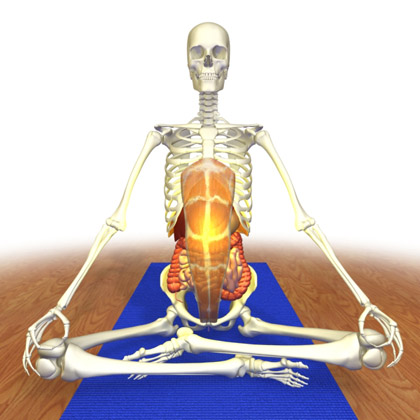
|
In Part I on the accessory muscles of breathing, we discussed the accessory muscles of the upper chest—the rhomboids and the pectoralis minor. This Scientific Key looks at the accessory muscles of the lower chest and abdomen, specifically the rectus abdominis, quadratus lumborum, and psoas. Let’s look at each of these muscles in turn. The psoas and quadratus lumborum are interrelated muscles, in that contraction of one evokes contraction of the other through neurophysiological connections. This works well because both muscles wrap around and stabilize the lumbar spine (see right). |
|
© 2007 Raymond A. Long MD. |
|
© 2007 Raymond A. Long MD. |
|
The quadratus lumborum originates on the medial iliac crest and inserts on the lower border of rib 12 (and the lumbar vertabrae). Contracting this muscle acts to arch the lumbar spine and draw the floating ribs down (see left). The psoas does not actually attach to the ribcage and so is not truly one of the accessory muscles of breathing. Contracting the psoas does, however, signal the quadratus lumborum to engage. The psoas also helps stabilize the lumbar spine during seated breathing exercises. To learn more about this important muscle, please click here for “Awakening the Psoas.” Activate the psoas in Sukhasana by first placing the hands on the knees. Attempt to raise the knees while resisting this action with the hands. You will feel the lumbar spine draw inward and stabilize (see left). This occurs because the hands prevent the insertion of the psoas on the femur from moving. Consequently, activating the psoas moves its origin on the lumbar spine, stabilizing it. Fixing the insertion of a muscle while moving the origin is called “closed chain” contraction. (To learn more about open- and closed-chain contraction in yoga, please see Scientific Keys Volume I) |
Finally, there is the rectus abdominis muscle. Originating on the pubic symphysis and inserting on the zyphoid process and ribs 5, 6, and 7, contracting this muscle increases intra-abdominal pressure. This action provides a light resistance for the diaphragm during inhalation, toning it. It also massages the abdominal organs The rectus abdominis also stabilizes the lower ribcage for bellows or bucket handle breathing (see Part I). Contracting the rectus abdominis activates udyana bandha, illuminating the third chakra (see below).  |
Practice tips: